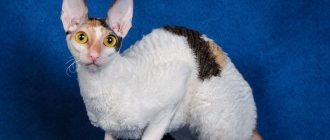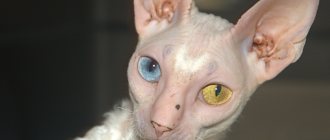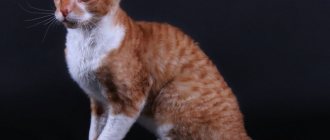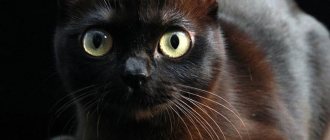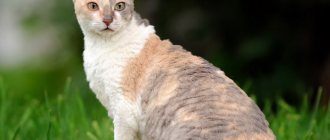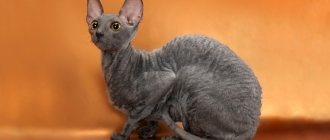03/31/2019 Irina Malinina 1 Comment
Cornish Rex is a breed that will not leave anyone indifferent. Initially, animals attract attention with their specific appearance. Slender body, big ears, expressive eyes - everything about this cat is non-standard. But its main distinguishing feature is its unusual wavy coat. It is thanks to this coat that curly cats have become known everywhere.
Having a cute pet, the owner will not go wrong. Indeed, in addition to their interesting appearance, cats have a wonderful character, good intuition and a sharp mind. They will easily fit into any family and quickly become its full member.
The name of the breed consists of two parts. The first part indicates the cat's birthplace: Cornwall. The second part is used to designate the gene for curly hair.
Description of the breed
The unusual-looking cats appeared as a result of a stable genetic mutation. Cats with fur like a sheep have excellent health and are unpretentious in their maintenance. For their protruding ears and external resemblance to their naked counterparts, the Cornish are called astrakhan sphinxes. The Cornish have a twin brother, the Devon Rex, but these breeds are not crossed with each other due to differences in genotype.
Appearance - what does a Cornish Rex look like?
Not too large, elegant and graceful cats with curly hair, large ears, a triangular muzzle and well-developed muscles.
American type
The American Cornish is distinguished from its English-type counterparts by its ovoid head and lighter bone structure.
The muzzle is wedge-shaped, the profile is rounded, the features of the muzzle are clear, the cheekbones are well defined, the stop is moderate or even, the skull is convex. The ears are wide at the base, rounded at the tips, resembling a cone in shape. The ears are set wide apart.
The forehead is rounded, the nose is “Roman”, the chin is courageous. The jaws are strong, with a scissor bite; a straight bite or a slight overshot is allowed. The head is set on a flexible and muscular neck of medium length. The body is slender, elongated, the stomach is tucked. The chest is well defined, looks strong, of moderate width. The long, whip-like tail gradually tapers towards the tip.
Relative to the body, the limbs look rather thin - the legs of the Cornish Rex are distinguished by lightness and thin bones. The paw is small, graceful, gathered in a tight bun. The fingers are long, the pads are shaped like an oval.
European type
“Europeans” differ from “Americans” in having heavier lines - they are less light and graceful, they have more powerful bones and the ovoid shape of the head is not as pronounced as their counterparts of the American type. In general, the differences between the two types are minor.
Size and weight
The height of an adult animal is 23-27 cm. The weight of an adult cat is 3-5.5 kg, cats are more graceful and weigh less than cats - 2-4.5 kg.
Wool
The curly Cornish Sphynx or astrakhan cat has soft and delicate, wavy, spineless fur like astrakhan fur. Cornish Rexes are cats with fur like a sheep's. On the chin, chest and tummy of the Astrakhan Sphynx, the fur is shorter and more curled than on the rest of the body. The Curly Cornish coat has no awn, the fur fits tightly to the body, forming uniform waves that are soft to the touch.
Colors
In addition to the common coat colors - black, white, red, blue, lilac, chocolate, etc., the breed standard allows almost any color. These are all varieties of tortoiseshell color, tabby, intricate torby - the Cornish Rex can have any coat color.
Astrakhan Sphynxes of Siamese color are called “C-Rex”.
Eyes
Large or medium-sized Cornish eyes resemble an oval in shape and look slightly slanted. The pigment of the iris must match the color of the representative of the breed.
Appearance (standards)
Photo: https://www.flickr.com/photos/titkov/11460748363/
Dimensions
Cats weigh about 3 kg. Cats are heavier, their weight is 4.5 kg.
Head
The Cornish Rex cat has a small, egg-shaped head.
Limbs and tail
The animal's legs are long and slender. The flexible and very mobile tail is long. The tail tapers towards the tip.
Coat and colors
A special feature of the Cornish Rex is its wool, which gives them a certain resemblance to a shorn lamb. The coat is short, silky to the touch, and has neither top nor guard hairs. The waviness starts from the head. Next, curly waves go along the back and sides and end at the tail, or rather at its very tip. The lower part of the cat's body is also wavy.
The pet's body must be completely covered with fur. If you find an area without fur, this is a reason to visit the veterinarian.
The Cornish Rex cat can have any color. The most common are the following: black, white, blue, calico, red. There are also silver Cornish Rex, cream, tabby, brindle, spotted.
Two-tone colors are considered the most valuable.
Ears
Large ears are shaped like a triangle. Set wide apart, positioned high on the head.
Locator ears make the Cornish Rex look like bats or magical elves from a fairy tale.
Eyes and nose
The animal's eyes are round and widely spaced. The bridge of the nose has a small hump.
The colors of the eyes and nose correspond to the color.
The standard allows eyes of different colors.
Features of a cat
The Cornish Rex is a short-haired cat. Her large ears, combined with bright eyes, give her a special appearance.
A cat's unique hearing allows her to hear even very quiet sounds that are inaudible to others.
The colors of animals are varied. There is even a tri-color color.
Cornish Rex eyes also have different colors. Sometimes you can meet a cat with blue eyes.
Owners consider blue-eyed kittens to be deaf or have hearing problems. Medicine does not confirm these fears.
The Rex cat has webbed paws located between the toes. This anatomical feature would make rexes good swimmers, but they are only wary of water.
An interesting feature is the Cornish Rex's ability to express its emotions using its tail, just like a dog. A raised tail signals a good mood. Exuberant joy manifests itself in intense tail wagging. And in all other emotions the tail also takes an obligatory part.
Are Cornish Rex cats hypoallergenic or not? How often do they shed?
People who suffer from allergies to cat fur gravitate towards Sphynx cats. Cornish Rex cats are so short-haired that they practically do not shed. It is still necessary to comb the Astrakhan Sphynx from time to time - periodically you need to remove dead short hairs.
Before getting a cat of any breed, allergy sufferers should remember that there are no completely hypoallergenic animals. Allergies can be caused not only by fur floating in the air, but also by pet dander, saliva, and animal waste.
Castration and sterilization
If you do not plan to breed Cornish Rex, then it is better to do castration (sterilization). The procedure is carried out when the pet turns 9 months old - the period of puberty. It is not recommended to do this before, which can lead to defective formation of the reproductive system.
Smooth fur in kittens is not a defect
The animal is operated on in a veterinary clinic under general anesthesia. Everything takes about 20 minutes, then the cat is given to the owner. The next day, the anesthesia is completely leveled, but the pet will need careful care for several more days. If after 24 hours the pet has not recovered from anesthesia, you must visit the veterinary clinic again.
It is worth noting that Rexes do not tolerate anesthetics well. Therefore, anesthesia does not always go well.
Cornish Rex and children
There is no need to be afraid that the cat and lamb will offend the owner’s baby. Owning Astrakhan Sphynxes is recommended for both single people and families with children. The friendly Rex from Cornwall will get along with both a teenager and a stupid child. Before getting a cat with fur like a sheep, you should carry out educational work with children. The child should be explained how it is possible, and most importantly, how not to treat animals.
Features of feeding and diet
Due to their increased activity, Cornish cats are constantly hungry. Be careful when feeding and follow your veterinarian's recommendations. An increased caloric intake is fraught with obesity and other complications.
For cats with metabolic disorders, veterinarians recommend periodic fasting. Please note that fasting days are carried out under the strict guidance of a doctor and do not always imply a complete refusal of food.
The animal's diet should be natural or dry. Mixing the two types is unacceptable and is fraught with disruption of the gastrointestinal tract. Dry food must be at least super premium. Pay attention to the country of origin. Good reviews are typical for Canadian production, while domestic producers still skimp on the quality of ingredients.
If you are in doubt about what food to feed your pet, consider the main indicators: age, health, general activity and size. Give preference to canned food with pieces of meat, as frequent consumption of dry food overloads the weak digestive system of the Cornish Rex.
Eating natural products requires strict adherence to daily caloric intake. Check with your veterinarian how many times to feed the Cornish to avoid obesity, deficiency or excess of vitamins. Until 1 year of age, focus on calcium, which is necessary for the proper formation of bone structure.
Contrary to popular belief, fish is dangerous for most cats and can cause urolithiasis. You should also avoid liver, which can change the color of the coat. Meat products should account for at least 80% of the diet.
Cost of kittens
The price of a baby from a cat-lamb depends on factors such as the health of the kitten, the absence of defects, the birth of the parents, the presence of breed characteristics and exhibition titles.
A small Sphynx Rex without documents will cost the owner 5-20 thousand rubles. Buying a Cornish Rex kitten with a pedigree will lighten your pocket by 20-65 thousand rubles.
Breeding
There are up to five newborns in one litter.
Representatives of this breed reach sexual maturity at the age of about 8-9 months. Just don't rush into knitting. We must give the young body time to gain strength and the hormonal levels to stabilize. Breeders recommend postponing this process until the cat's second heat.
A partner is selected in advance. This is due to the rarity of the breed. According to the standard rules, Cornish cannot be mixed with representatives of other breeds, so as not to lose the dominant gene - responsible for curly hair, large ears and a typical physique.
When choosing a female cat for the upcoming mating, adhere to the standard rules:
- impeccable pedigree;
- excellent health;
- experience in this matter.
If the “groom” has already lost his “virginity,” the likelihood of pregnancy on the first try increases significantly.
Before such a significant event, both pets must undergo antiparasitic treatment. Claws are trimmed so that the couple does not injure each other in a fit of passion. It is advisable to refuse vaccinations. It is better for the pimping to take place in the cat’s home. They bring the cat there and leave it for several days (maximum 5-6).
Gestation lasts from 63 to 65 weeks. Usually childbirth proceeds easily, without outside help. The onset of labor is marked by changes in the behavior of the woman in labor - anxiety appears, a desire to hide somewhere. Babies are born weighing no more than 100 grams. There are up to 5-6 of them in a litter. Their fur is curly, but soon straightens out. It begins to curl again after the first molt.
Cornish Rex kennels
To be sure that you are purchasing a high-quality animal, it is better to buy kittens in specialized nurseries where Cornish Rex cats are bred.
Here is a small list of names of nurseries engaged in breeding Cornish cats:
- "CORNELIAN" (Moscow)
- “Chocolate Joy” (single-breed cattery for short-haired cats, St. Petersburg);
- "Kornelita" (Moscow);
- "Amadeus" (Kharkov);
- "REXY" (Moscow);
- "REX GRACEFUL" (Moscow).
Recommendations for choosing a kitten
If the decision to get a Cornish Rex has been made, then first you need to decide on the gender of the animal, because the temperament of male and female individuals differs. Cats are calmer and more attached to their owner; cats are curious, active and restless, but at the same time they are very affectionate.
To choose the right kitten, you should use the following expert advice:
- buy a baby in specialized nurseries or from trusted breeders, this is the only way to avoid getting a sick or out-of-breed animal;
- obtain maximum information about parents, evaluate their behavior, socialization, health;
- take the kitten home only when it reaches 2.5-3 months, so that by this time it has learned the necessary life skills from its mother and becomes independent;
- examine the kitten for diseases and defects (discharge from the nose and eyes, cleanliness of the ears, the presence of fleas, ticks, quality of fur and skin, size and softness of the abdomen, etc.);
- check the accuracy of the documentation (certificates of origin, permission to obtain a pedigree, veterinary passport indicating all vaccinations and the date of their implementation).
The price for representatives of the breed varies from 25,000 rubles for pet-class individuals, subject to mandatory sterilization, to 50,000 rubles for show-class babies who can take part in exhibitions. If a kitten is purchased for further breeding, then its cost usually does not exceed 30,000 rubles.
Care and maintenance
Caring for a short-haired, curly pet is not at all difficult - even a person who has never owned a cat can handle it. The animal should have individual drinking bowls and food bowls, scratching posts, toys, as well as its own personal place in the house where it can rest from the hustle and bustle.
From a young age, the Astrakhan Sphynx should be accustomed to hygienic procedures - trimming claws, washing eyes, cleaning ears and teeth.
It is better to take care of animal hygiene at a time when the pet is in a good mood; in no case should you do it forcibly. To treat the ears, it is advisable to purchase a special lotion; the eyes can be washed with a cotton pad dipped in ordinary boiled water.
If your pet is found to be sour, instead of boiled water you should use either tea leaves or chamomile infusion. If the redness does not go away, or discharge from the eyes does not disappear after treatment, the animal should be shown to a veterinarian.
The oral cavity of cats is treated once a month. To do this, use a special finger attachment and cat toothpaste. If you don’t have a nozzle, it doesn’t matter; you can get by with a sterile bandage wrapped around your finger for these purposes.
What to feed
Due to excessive activity and the lack of long hair, which would help provide the animal with the necessary thermal balance, Cornish cats experience hunger more often than their woolier counterparts. Because of this feature, the Cornish may seem like a glutton, always begging for tidbits.
The owner should not succumb to such provocations from his curly-haired Cornish Sphynx. Dry food should be given within the daily allowance determined by the manufacturer, otherwise excessive food can lead to obesity.
If the owner prefers to feed the pet dry balanced food, breeders recommend at least occasionally diversifying the cat’s diet with natural food.
If the owner wants his cat to eat natural food, products such as lean meat, boiled sea fish, cottage cheese, fermented milk products, cereal porridge, fresh and boiled vegetables are suitable for the Cornish. Many Cornish people love greens and sprouted oats.
The curly-haired Sphynx should not be given fatty foods, bony river fish, flour, sweet, or salty foods. It is also undesirable to give milk to cats; it is better to replace this product with fermented milk products. Prohibition on pork, liver (not digestible), bones, leftovers from the master's table, food with spices and herbs.
Grooming
The curly, delicate fur of the sheep cat is so short that it does not require daily brushing. It is enough to collect short dead hairs from your pet’s astrakhan fur coat a couple of times a week using a comb or a piece of hard terry towel.
Short-haired Cornish cats need to be bathed when they get dirty, but this should be done much more often than their long-haired counterparts. The hairs on their curly coats are too short, so they do not absorb sweat and oil from the pet's skin well. If the Cornish Rex is not bathed on time, it can lead to skin diseases. It is better to wash the fur of a lamb cat using a special shampoo for cats with short hair.
Potential Health Problems
In general, representatives of the Cornish Rex breed are distinguished by good health and high immunity. However, astrakhan cats often have such unpleasant sores as “greasy tail”, metabolic disorders, and retinal atrophy.
Diseases and health problems
Under good conditions, cats of this breed can celebrate their twentieth anniversary. Despite their random origin, they can boast of excellent health. No diseases are inherited along the genetic line. If they get sick, they recover quickly without consequences. This is due to the innate strong immunity in animals.
Diseases to which Rexes are susceptible:
- Hypothyroidism. It develops due to a lack of thyroid hormones in the body, which leads to damage to the dermis, fur and loss of appetite.
- Hypokalemia. Appears against the background of calcium deficiency. In rare cases, it is inherited from parents.
- Hypotrichosis. Increased hair loss - baldness. At the same time, the cat’s well-being does not deteriorate.
- Alopecia. Partial baldness (on the stomach, paws, sides). The cause is hormonal imbalance and lack of vitamins.
Sometimes Cornish Rexes develop retinal atrophy.
If the room is drafty, there is a high risk of your pet catching a cold. Cystitis may develop as a complication. It is important to maintain a favorable temperature.
Pros and cons of the breed
The positive aspects of living under the same roof with a Cornish Rex include their affection and friendliness. An active and cheerful curly cat will not let you get bored alone, and by cuddling and purring his tender song in his owner’s ear, he will lift his spirits and lift him out of despondency. A kind of curly antidepressant. The Astrakhan cat is clean, easy to train, and has the ability to perform simple tricks. Cornish cats are easy to litter train and have no odor.
The point about the disadvantages made me think for a long time - it seems that the cat-lamb has no disadvantages. The only minor drawback may be the occasional stubbornness shown by the Cornish people. But a cat’s self-will and presence of its own opinion are a manifestation of its intelligence.
Interesting Facts
Despite the fact that the Cornish Rex breed appeared not so long ago, a lot can already be said about it. Here are some fun facts:
- Loyalty to the owner is akin to that of a dog. The cat is ready to follow him anywhere. Constantly rests on knees or shoulder. Sometimes he even tries to climb on his head.
- They are unique in terms of intelligence, so they are easy to train. If desired, it is not difficult to teach a pet various tricks: to bring thrown objects, to respond to dog commands.
- Since these cats do not have guard hairs, the coat does not retain heat. Therefore, it is better to buy an insulated house-bed for your pet’s rest.
- This breed is suitable for allergy sufferers - their fur does not cause a painful reaction in them. True, they shed no less than other cats, so you will have to clean the house often.
- Prolonged exposure of the Cornish Rex to the sun can cause burns on the skin. Therefore, it is recommended to walk them in the morning or evening, when solar activity is minimal.
- Corniches are very gluttonous. It is better to underfeed them once again. With systematic overeating, they quickly get fat, become lazy and clumsy. Experts advise giving them a fasting day once a month.
- To get healthy kittens from your well-born cat, you should not allow frequent births. Once every couple of years is enough. But you can’t extend the pause either. Then disturbances in the reproductive system may develop.
History of the breed
Curly-haired cats were bred quite recently - the Cornish Rex breed appeared in 1983. The story of the curly foundling began in the 50s of the last century in Great Britain. On one of the English farms, an extremely large-eared kitten with unusual curly fur was born. The long-eared curly cat was named Kalinbuker. An unusual-looking mutant was born at a difficult time for people; the British had no time for breeding cats at that time. They even wanted to castrate poor Kalinbooker, but somehow this didn’t work out, fortunately for lovers of the Cornish Rex breed. After listening to the advice of a veterinarian, the owner of the infernal kitten, Nina Ennismore, decided to match the lamb-like Kalin with his completely ordinary, smooth-haired mother. The result was surprising - the litter included both smooth-haired and curly-haired kittens.
Then the unusual curly cats came to the United States, and American felinologists began breeding. Breeding the Astrakhan Rex lasted for 30 long years, but now cat lovers have the pleasure of keeping a curly “alien miracle” in their home.
Historical reference
Country of origin: England. The history of the Cornish Rex began in 1950, when a yellowish-white cat with an unusual wavy coat appeared in Cornwall. The animal was shown to geneticist Jad A.S., who revealed the presence of a mutant Rex gene. Subsequently, the cat was bred to his tortoiseshell mother, and kittens with wavy fur appeared in the litters. The breed was named "Cornish Rex", the word "Cornish" indicating the place of origin (Cornwall), and the word "Rex" indicating the wavy coat gene.
Since the population of these animals was very small, they were crossed with American, Siamese, and Havanese cats. However, today matings with other breeds are not allowed in order to preserve distinctive features. The Cornish received official recognition in 1967. In 1983, 3 main branches were identified - Cornish, Devonian, Germanic, and changes were made to the standards.
The breed first appeared in Russia in 1989; animals were brought to the exhibition of the FPC “Sirius” from Sweden and Finland. A year later, the first nursery called “Santa Berger” was created in the country. Every year the number of Cornish Rex cats in Russia is increasing more and more, and the number of fans of the breed is also growing.
Interesting facts about Cornish Rex cats
- What is the difference between a Cornish Rex and a Devon Rex? Why is it impossible to breed representatives of these outwardly similar breeds?
Representatives of the Devon Rex and Cornish Rex breeds are not crossed due to differences in the genotype; they do not have common relatives.
- Why does the astrakhan cat eat so much?
The Corniches were known as gluttons due to the fact that they were constantly haunted by a feeling of hunger. This occurs because lamb cats are extremely active. Plus, their fur is too short to properly maintain body heat balance. Therefore, curly-haired cats are always not averse to eating in order to gain strength or warm their bodies.
- Why does a lamb cat have claws visible?
One of the peculiarities of the breed is the fact that Cornish cats do not know how to completely hide their claws, like other cats. Therefore, the Cornish Rex's claws are always visible.
- Will a Cornish get along with a dog?
Yes, easily! Moreover, the Cornish man and the dog will become friends. But whether the friendship between a dog and a Cornish Rex will be strong, without offense, will depend on the behavior of the owner. To ensure that the curly-haired cat does not have any grudges against the dog, the owner of the animals must pay more attention to the Cornish than to the dog. Otherwise, the cat-lamb will be offended - if the owner’s attention is divided fairly, that is, in half, then the Cornish will be jealous of the owner of the other pet. A cat-lamb will be friends with a dog only if it receives more attention than the second pet.
Health
The painstaking work of breeders helped create a breed with good health and virtually no genetic diseases. Diseases such as hypokalemia (potassium deficiency), retinal atrophy, and alopecia occur quite rarely.
The Cornish Rex is not immune to colds, fleas and worms, vomiting and diarrhea and other common diseases that any cat can catch.
It is recommended to remove internal parasites every three months. Regularly inspect your pet's fur to detect the presence of fleas in time. By avoiding drafts and prolonged hypothermia, you can protect your pet from colds. And by removing poisonous indoor plants from your apartment that your cat can chew, you will protect her from poisoning.
Photo
Video “Unusual cats from England”
In this video you can immediately see and learn all the differences and features of the two English breeds.
Was this article helpful?
Thank you for your opinion!
The article was useful. Please share the information with your friends.
Yes
No
X
Please write what is wrong and leave recommendations on the article
Cancel reply
Rate the benefit of the article: Rate the author ( 2 votes, average: 3.50 out of 5)
Discuss the article:
Owner reviews
The owners of Astrakhan cats say that there is no better pet than a therapy cat. The favorite thing of curly-haired healers is a massage, given with love to the owner and his family members. Sheep cats love to gently knead their owner's body with their paws, and bite and lick the hands of a person they trust. This is how the Cornish Rex expresses its love and devotion. Cornish cats are praised for their cleanliness - they are easy to litter train. Curly-haired cats are extremely smart and easy to train.
Cat character, habits, training
Cornish Rexes are friendly, they get along well with other pets, and are loyal to children. The main character trait is playfulness. Both kittens and adult animals love to frolic, catching toy mice, bows from candy wrappers or pieces of fur on a cord.
Pets are very active and love to explore their surroundings.
Cats of this breed need a person, become attached to him and are ready to follow him everywhere. They adapt more easily to moving than to the owner’s frequent business trips.
Cornish Rexes are friendly, they get along well with other pets, and are loyal to children.
Cornish people do not tolerate shouting or swearing . They may worry about a door slammed in their face. The breed is not considered aggressive.
These unusual animals are very smart and amenable to training. They can be trained to fetch small objects, which cats deftly pick up with their front paws. Cornish cats are also able to learn simple commands - “sit”, “lie down”.
Pets can easily tolerate walks on a leash for small dogs. They can feel comfortable in the company of unfamiliar people, especially if they have been accustomed to this since childhood.
Animals love to sit on their owner's shoulder or bask on his lap. They are willing to make contact with guests at home.
Males of this breed do not mark territory and do not shit in the apartment.
Origin
England is the homeland of amazing cats with big butterfly ears, unearthly eyes and a huge loving heart.
And it feels like they appeared there straight from a hobbit hole or a gnome’s cave. In any case, the first Devon Rex cat disappeared into the thicket of the forest very quickly, as if it had hidden in the secluded house of the owner of the forest.
But his companion turned out to be more loyal to people, and the kitten born by her became the founder of a new race of cats.
This happened in the middle of the 20th century. Europe almost immediately accepted the new breed, but America for a long time refused to recognize the appearance of the Devon Rex, considering it a variety of the Cornish Rex.
It is believed that the breed is still in its infancy. The gene pool of animals is very small, so work on crossing with other breeds continues.
What do people with mustaches get sick with?
This is a very healthy cat breed. Basically, they do not have any special or genetic diseases. With an active lifestyle, proper care and nutrition, Cornish dogs can live more than 20 years.
However, some genetic lines of cats are susceptible to specific diseases such as hypothyroidism and hypotrichosis.
Hypothyroidism is a disorder of the thyroid gland, as a result of which the animal becomes weak, the skin and hair are damaged, and appetite is impaired. Treatment for this disease should only be prescribed by a veterinarian. By purchasing an animal from a good nursery, the likelihood of encountering such a problem is very minimal. Hypotrichosis is a disease that causes hair loss. Cats who have this congenital disease have uneven hair, which forms bald patches. As a rule, this problem is only cosmetic and does not pose a threat to the pet's health.
Nutrition
The Cornish's main diet is wet canned food; dry food makes up only a sixth of their diet. If the pet is naturally fed, then the diet should be planned so that 2/3 of it consists of meat and offal. An ideal source of protein is beef or minced beef. You can also offer your pet rabbit, turkey or boiled chicken.
It is highly not recommended to give cats fish, because it provokes the development of urolithiasis. Sour cream and cream are allowed only for adults, but for children it is better to give children's cottage cheese without additives.
Due to their high physical activity, they have a voracious appetite and are ready to eat whatever is offered. However, in old age it can lead to obesity. In order for the pet to stay in shape, the owner must control its diet.
Character of the Ural Rex
The Ural Rex is not characterized by such truly feline character traits as the desire for independence and arrogance towards others. Moreover, a pet that “professes” contempt for representatives of the domestic fauna and persistently tries to prove its superiority to its owner is a kind of phenomenon that makes one seriously think about the question of the animal’s purebredness. The correct Ural Rex is an invariably affectionate and playful cat, although it does not suffer from excessive clinginess. This comrade tries to extend his natural charm not only to people, but also to the rest of the four-legged inhabitants of the house.
This is not to say that the representatives of the Rex family are such soft-hearted goodies - in the mood, the “Urals” are not averse to fooling around and playing with little things dear to your heart, throwing them off the shelves and tables. However, in general, “gangster” habits are not typical for the breed, so if the cat is a hooligan, it is for one single purpose - to seduce you into participating in his games. For example, one of the favorite cat activities is fetching toys. According to the owners of the breed, curly-haired kitties devote themselves to this activity entirely and completely as long as the owner is ready to throw a cloth mouse or ball. Sometimes the Rex is not averse to hunting, which is completely natural: the instincts of the Ural ancestors, who hunted small rodents, are still strong in the breed.
In relations with their fellow tribesmen, the Urals are friendly and peaceful. Cats are very kind to their own babies. Cats, in turn, do not try to deal with newborn offspring, which was often practiced by their outbred ancestors. On the contrary, the fathers of the Ural Rexes turn out to be first-class, and on occasion they are always ready to babysit the younger furry generation. Otherwise, “curly cats” are unusually cute, but quite typical cat cats who love to sunbathe and relax on windowsills, love treats and consistently violate the boundaries of their owner’s personal space in the morning.
